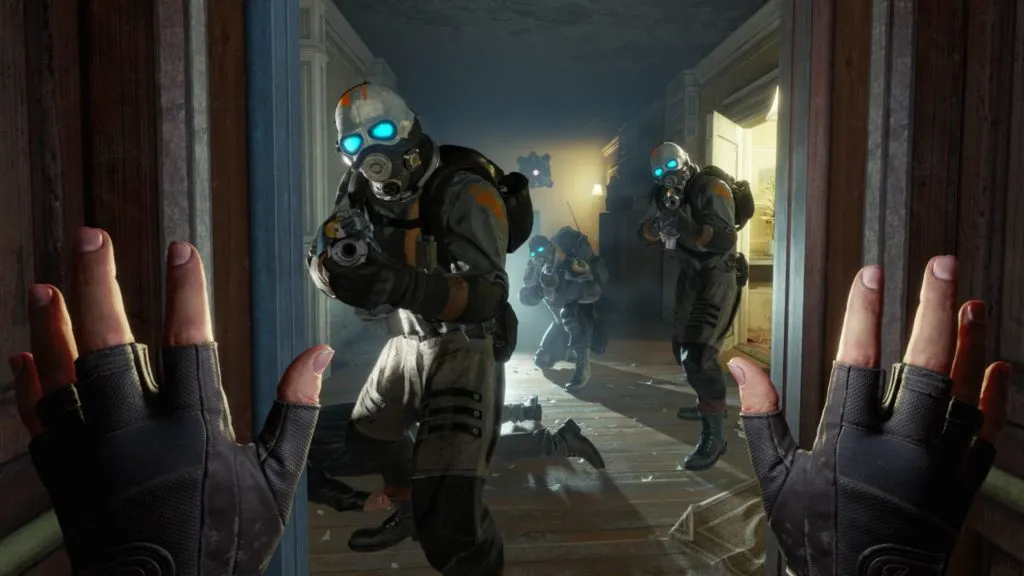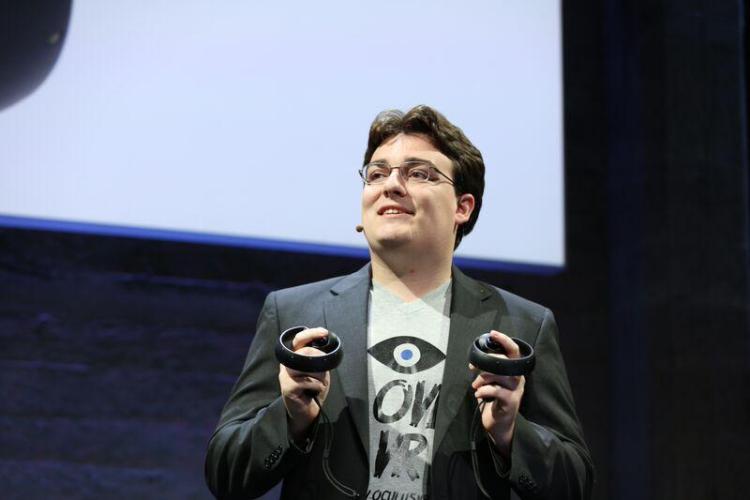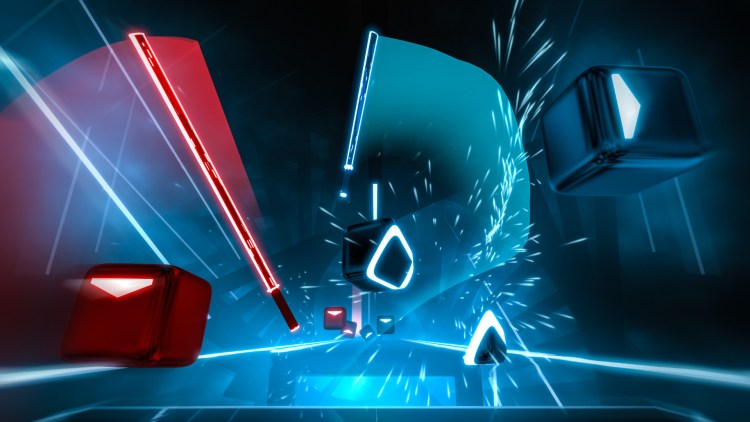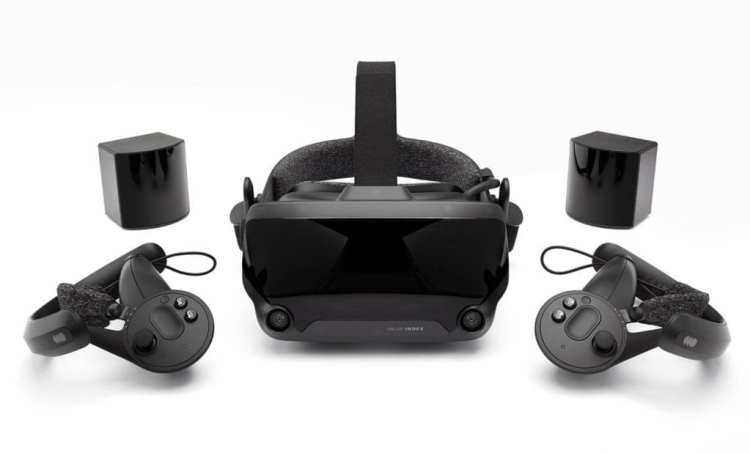Guns. Avatars. Teleporting. Lightsabers. Nausea. It took years to get there and a lot of experimenting, but one of the most notable tech developments of the last decade is that virtual reality went from being a fantasy to An Actual Thing. A thing that really works (sorry, Virtual Boy) and you can have in your home. New hardware product lines, completely new kinds of games. It’s fitting that the decade in PC games closes out with Half-Life: Alyx on the horizon. VR has a much wider scope than gaming, to be sure. But it was the passion and imagination of PC gamers that made it happen.
The ’90s dream had died
At the beginning of the current decade, virtual reality’s success would have been hard to predict. There had been something of a VR craze in the early ’90s, but it had long since faded. VPL Research, co-founded by tech talking dread-head Jaron Lanier, had come up with VR equipment like the DataGlove, DataSuit, and, uh… EyePhone. The EyePhone, an early head-mounted display (HMD), sold for an eye-watering $49,000 USD.
This was back in the late ’80s, and as such, it was limited by the graphics technology of the time. Although a sign of things to come, VPL wasn’t commercially viable and filed for bankruptcy in 1990.
Not even Sega and Nintendo, the two titans of the ’90s console wars, could make VR cool in their heyday. Sega announced the Sega VR in 1991. Intended for the Genesis/Mega Drive, the HMD could boast dual LCD screens and built-in head tracking and stereo earphones. Not bad for $200 USD in ’90s money (about $353 USD nowadays). Despite being hyped up in gaming mags with Sega’s signature edgy style, the product was quietly killed, likely because the device caused dizziness and headaches with test users.
In 1995, Nintendo actually released the Virtual Boy, a VR headset on a stand that could only display black and red vector graphics. Virtual Boy was not a success, largely because of the same health issues for young users. Our own managing editor Cameron Woolsey described it as a “migraine machine.”
The tech was so limited that the VR scene lay dormant for a good long time. To appreciate just how remarkable the progress of the last decade is, consider how long virtual reality was literally the stuff of science fiction. Growing up in the ’90s, I’d see VR represented in movies (from Lawnmower Man to The Matrix) or Saturday morning kids shows (VR Troopers, The Real Adventures of Jonny Quest). Virtual reality was cyberpunk kitsch, a trope of sci-fi novels like Neuromancer and Snow Crash. But there wasn’t a sniff of it in real life.
A Luckey break
Enter the present decade. Palmer Luckey designed the prototype for the Oculus Rift in 2010. Luckey then opened the Kickstarter for the project in 2012 with a goal of $250,000 USD, but backers channeled almost $2.5 million USD into the VR dream. (Luckey would later flip Oculus to Facebook for a cool $3 billion USD, much to the chagrin of backers.) When id Software’s John Carmack joined Oculus as CTO in 2013, Oculus had a serious PC gaming heavyweight onboard, even if there was legal trouble down the line.
Meanwhile, Valve had been working on its own VR tech, freely sharing breakthroughs with Oculus and others in a collaborative spirit as well as working on hardware with HTC. After 20 years in the wilderness, VR was picking up steam (ahem) again.
The year 2016, when the first commercial Oculus Rift and HTC Vive units shipped, was a major milestone for virtual reality. Sure, they were clunky, expensive, and uncomfortable. The base stations for motion sensors were a pain in the ass to set up, but it was science fiction in your living room. Windows Mixed Reality headsets from Lenovo, Samsung, HP, and more followed, taking advantage of Valve’s SteamVR platform to offer more affordable VR PC gaming hardware.
Outside of the PC gaming space, the PlayStation VR brought the experience to consoles, and mobile virtual reality was all the rage with ranges like Google Cardboard and Samsung’s Gear VR collaboration with Oculus.
While strapping your smartphone to your face is thankfully falling out of fashion, PC VR is becoming more refined and affordable in a relatively short time frame. The latest generation of headsets sports improved displays as well as innovations such as better inside-out tracking cameras. The Valve Index, the latest challenger in the race, touts the long-awaited “knuckles” controllers. Finally, your VR avatar will have real fingers instead of claw-like grabber hands.
We’re playing Beat Saber
Having the hardware is all well and good, but what about the actual games? The gimmick of immersion only goes so far, but the games had better be worth it, especially after spending hundreds of dollars and risking a stomach-churning time. The truth is that the VR landscape has the good, bad, and ugly features just like anywhere else.
But the last few years have seen the library of available virtual reality games grow to include some stellar titles. Even somewhat awkward ports like Bethesda’s Skyrim VR and Fallout 4 VR can offer a newly immersive perspective into open game worlds. Both Elite Dangerous and No Man’s Sky have great VR modes for wannabe space captains. There are excellent VR-only single-player games like Superhot VR, Apex Construct, The Mage’s Tale, and Moss.
That’s to name but a few. Still, there’s a clear winner for the most definitive VR game to date. Beat Saber managed a perfect storm. Immersive but not uncanny graphics, addictive gameplay, and plenty of motion from a fixed position. The laser sword rhythm game became the closest thing VR had to a killer app, and it spread to every major VR platform.
Not bad for creator Beat Games, the indie studio from Prague that was recently acquired by Facebook. No doubt the news was met with more than a few groans. Like it or not, the social network giant has been a key player in virtual reality in these critical years and will continue to be one going forward. The more the lessons of Beat Saber help the mainstreaming of VR, the better.
Coming in at a photo-finish at the end of the decade, Boneworks also deserves a place in the VR canon. The action game boasts intricate physics that curiously bring to mind the feeling of playing Half-Life back in the day. It’s certainly made an impression, shooting into Steam’s top 100 and reaching over 8,700 concurrent users just a few hours after its release, around double Beat Saber‘s record on the platform.
Half-Life: Alyx, halfway there
Over the past few years, I’ve had all sorts of gizmos strapped to my head and flailed like a madman working out different movement systems. I’d be lying if I didn’t mention the sweat and puke along the way. I’ve also heard a lot of naysaying from industry pundits declaring VR dead, that it’s just not selling enough to justify continued investment as a consumer product. But the latter half of the twenty-teens is just a short slice of virtual reality’s history.
From that perspective, we’re seeing a lot of progress very quickly. VR is slowly making its way through varying industries — engineering, medicine, architecture, tourism, and shopping — but PC gaming is always going to be at its heart.
To illustrate this, look no further than Half-Life: Alyx. If the Index weren’t enough of an indication that Valve was going all-in on VR, then the revival of the company’s signature Half-Life franchise in VR form seals the deal. Valve confirmed to UploadVR that Alyx will have (nonessential) interactions specialized for the Index controllers, and the game announcement has been a big driver for Index sales.
2020 vision
This decade, virtual reality truly arrived. But it’s far from the last stop. Looking ahead into the next decade, the 2020s should see VR become more affordable and convenient. Yet the crucial issue of nausea is still a deal-breaker for many. If companies like Facebook are betting on mass adoption, it needs to be a priority.
Ultimately variation in human biology will always leave some individuals uncomfortable, just how there are people who can’t play FPS games today. But improvements in visual fidelity (and different locomotion options in-game) can mitigate this.
The standalone Oculus Quest, powered by a mobile Snapdragon SoC, can’t be considered a part of PC gaming. But it is one of the best virtual reality solutions out there. Relatively lightweight and cable-less, it sacrifices visual quality for convenience but also teases what conveniences PC headsets of the future could bring. There’s already progress on reducing the number of sensors and cables while still taking advantage of your PC’s GPU.
If there’s anything I’m personally most excited for, it’s not hardware but the games themselves. The decade has seen the live-service game ascendant, with plenty of suspect monetization mechanics affecting the design of PC games for the worse. The VR scene, however, can’t afford to do this with its relatively small user base. Many enthusiastic indie creators have been taking big risks with VR, and their passion shows in their work.
Freed from industry trends and more controlled by their creators, many VR titles actually remind me of ’90s games — in a good way. Even if VR gaming rapidly accelerates adoption into the mainstream, I’d say we have at least a few more years of open-minded creativity in the field. The upcoming ’20s could well be the best time to get behind some cyberpunk goggles. I know I’ve got mine.









Published: Dec 23, 2019 10:00 am